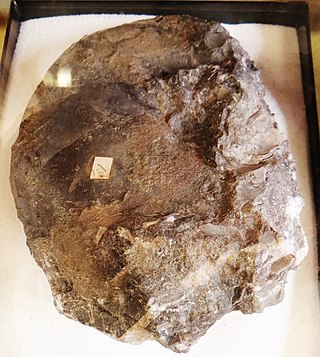
The Nautilida constitute a large and diverse order of generally coiled nautiloid cephalopods that began in the mid Paleozoic and continues to the present with a single family, the Nautilidae which includes two genera, Nautilus and Allonautilus, with six species. All told, between 22 and 34 families and 165 to 184 genera have been recognised, making this the largest order of the subclass Nautiloidea.

The Bactritida are a small order of more or less straight-shelled (orthoconic) cephalopods that first appeared during the Emsian stage of the Devonian period with questionable origins in Pragian stage before 409 million years ago, and persisted until Carnian pluvial event in the upper middle Carnian stage of the Triassic period. They are considered ancestors of the ammonoids, as well as of the coleoids.

The Tarphycerida were the first of the coiled cephalopods, found in marine sediments from the Lower Ordovician to the Middle Devonian. Some, such as Aphetoceras and Estonioceras, are loosely coiled and gyroconic; others, such as Campbelloceras, Tarphyceras, and Trocholites, are tightly coiled, but evolute with all whorls showing. The body chamber of tarphycerids is typically long and tubular, as much as half the length of the containing whorl in most, greater than in the Silurian Ophidioceratidae. The Tarphycerida evolved from the elongated, compressed, exogastric Bassleroceratidae, probably Bassleroceras, around the end of the Gasconadian through forms like Aphetoceras. Close coiling developed rather quickly, and both gyroconic and evolute forms are found in the early middle Canadian.
Bickmorites is an extinct nautiloid cephalopod genus known from the upper Ordovician to the middle Silurian of North America and northern Europe (Norway).
Uranoceras is a barrandeocerid genus from the Middle Silurian belonging to the family Uranoceratidae, characterized by its loosely coiled, gyroconic shell of 1.5 to 2 subquadrate whorls.
The Naedyceras group comprises three similar and closely related openly coiled, gyroconic, genera within oncocerid family, Brevicoceratidae: Naedyceras, Gonionaedyceras, and Gyronaedyceras.
Stereotoceras is a Middle and Upper Devonian genus in the oncocerid family Brevicoceratidae that formed a smooth, depressed, gyroconic shell with the dorsum much flatter that the venter. Sutures are straight ventrally but have dorsal lobes. Growth lines outline a ventral hyponomic sinus but are otherwise transverse. The siphuncle in ventral, nummuloidal, with discrete, irregular, actinosiphonate deposits at the septal foramina.
Laureloceras is a genus of the tarphycerid family Plectoceratidae that lived during the Middle Silurian in what is now North America.

The Barrandeoceratidae is a family of coiled nautiloids included in the Tarphycerida that lived from the Middle Ordovician to the Middle Devonian, characterised by mostly compressed shells with a subcentral siphuncle composed of thin-walled segments that may become secondarily ventral.(Flower and Kummel 1950, Sweet 1964).
The Uranoceratidae is a family of Silurian barrandeoceroids that tend to become uncoiled with age and in which siphuncle segments tend to be expanded into the camerae.
Cummingsoceras is a genus of barrandeoceroids within the Tarphycerida, included in the family Uranoceratidae. Its shell is a rapidly expanding gyrocone of about 1.5 narrowly separated whorls.
Cliftonoceras is a genus of barrandeoceroid type tarphycerids from the Uranoceratidae characterized by a smooth gyroconic shell with a rounded dorsum and flattened venter, and by a subvental siphuncle composed of thin connecting rings and necks that are straight ventrally, recumbent dorsally.

Lechritrochoceratidae is a family of derived tarphycerids from the middle and upper Silurian, once included in the now largely abandoned Barrandeocerida.
The Barrandeocerina comprise a suborder of Early Paleozoic nautiloid cephalopods, primitively coiled but later forms may be cyrtoconic, gyroconic, torticonic, and even breviconic, all having empty siphuncles with thin connecting rings. The Barrandeocerina were originally defined as a separate order by Rousseau Flower, but since then have been united within the Tarphycerida as a suborder. Derivation is from the Tarphyceratidae.
The Nephriticeratidae is a family of early Paleozoic nautilod cephalopods included in the Barrandeocerina, distinguished by mostly cyrtoconic as well as gyroconic, sepenticontic, and sinstrally torticonic shells with large, typically straight necked (orthchoanitic) siphuncles. As for the suborder, connecting rings are thin.
Avilionella is a Middle Ordovician tarphyceroid genus consisting of closely coiled, compressed shells with a small perforation in the center, shallow dorsal impression, and subventral tubular siphuncle with thin connecting rings. Chambers are very short, separated by closely spaced, dish-shaped septa. Coiling becomes loose in the mature, adoral, part of the shell.
Chidleyenoceras is a Middle Ordovician tarphyceroid with a closely coiled, evolute shell; whorl section subquadrate, widest just above a broadly rounded venter; dorsum with a broad shallow impression; sutures moderately spaced, weakly sinuous; siphuncle large, subventral, apparently orthochoantitic with tubular segments.
Plectoceras is a genus of nautiloids included in the tarphycerid suborder Barrandeocerina that lived during the Middle and Late Ordovician. It has been found widespread in the Middle and Upper Ordovician of North America.
Haydenoceras is a genus of middle Devonian cephalopods originally placed in the Barrandeocerida. The genus can be recognized by its strongly compressed, gradually expanding exogastrically curved shell with a strongly rounded dorsum and acutely angled venter, calling attention to the general form of earlier Bassleroceras. The siphuncle is tubular, central.
Charactoceras is a tarphycerid genus cephalopod which lived during the Late Ordovician.




